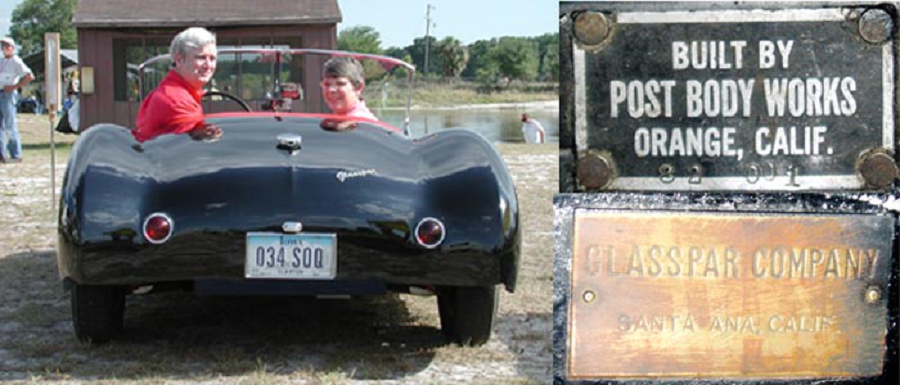
Hi Gang…
I met Tom Chandler several years ago thru my friendship with Pat Hoover. Pat was running the Glasspar G2 enthusiast website that he took over from his father, Bill Hoover, and was kind enough to involve me with some of his research and communication. In this case, Tom Chandler had contacted Pat, and was looking for more information about his Glasspar G2. Little did Pat know it, but we were looking for Tom Chandler too – but for different reasons.
Tom found his G2 back in 1982. It was actually a “barn find” of sorts. The G2 was at a specialty car dealership in Davenport, Iowa but had been pushed to the back corner of the showroom and had been there about 5 years. The dealer had acquired it from someone in Illinois. Hopes of someone finding the car interesting had started to fade and that’s how it ended up in the corner – neglected and forgotten.
Tom spotted the car at just the right time. At first he thought it was a Woodill Wildfire, but learned it was a Glasspar G2 – something he’d never heard of. The G2 was a complete and running car. The dealer was told that it was sent to the Midwest in the 1950’s to star in the Chicago Auto Show (neither Tom or I have been able to confirm a Glasspar at an early Midwest show in 1952 or 1953 – but we’re still trying!).
Tom was excited about his “find” at the back of the dealership, bought the car and drove it home that same day – in the rain. It did have a fiberglass top though. It’s just he couldn’t use it – it had never been fit to the car with the proper fasteners. Tom had to return later to pick up the original fiberglass top and bring it home.
This G2 was one nicely finished car back in 1952. Rodney Packwood and I were already on the hunt for the G2 with the first “Shorty Post” frame. If we could find it and date it – we could establish another milestone of Glasspar’s G2 development and further document the history of the company and the car. It turns out that Tom’s G2 was the car we were looking for. Rodney and I were ecstatic!
Just One Door – Better Than No Doors at All
Another interesting feature of Tom’s G2 is that it has just one door – on the passenger side. This speaks to it being an early car as well. Apart from the Brooks Boxer – the first Glasspar G2 – very few other cars had no doors. The early cars had one door on the passenger side, and if you wanted to splurge, you could order a driver’s door too! Another reason for having just one door is that early racing regulations required cars to have at least one door, headlights, and a spare tire too. Sometimes even a tool kit. The history of early racing in these years is very interesting – look it up if you have some time. You’ll have great fun.
So….having no doors is probably the best way to go in terms of building a fiberglass car. It keeps the strength of the body at its very best. The more doors you have, the more work you’ll need to do to strengthen the body to keep the body and the openings from flexing. Even so, as Glasspar produced more G2 bodies, more cars were ordered with two doors. So… as a general rule, 1 door means early car (1952 thru early 1953), and two doors means later car (early 1953 thru late 1954).
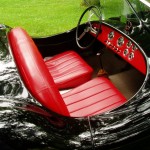
Attractive Red/Black Color Combination and Exquisite Interior Make This One Impressive G2 – Shorty Post and Bill Tritt Would Be Proud…
Short Post Frame #001 – Dated August 1952
As frame 001, no doubt, Shorty Post built this car for Bill Tritt or for one of his customers. It would have debuted around August or September 1952 as a finished car, and the fact that Harold “Shorty” Post built fully finished G2 cars as well as frames for interested customers – this car would have been “dressed to the nines….”.
During the restoration of this car, Tom noted that the fit of the body to the chassis was quite good – and precise. It had wooden floorboards, it retained its original 1941 Mercury engine, Ford 3 speed transmission, transverse springs front and rear, lever arm shocks in the rear and tube shocks up front (Tom has since updated all shocks to modern tube type), standard Ford steering box, and had 1939 Ford “wide five” rims.
It’s one of the few G2’s that appears to be a factory produced Glasspar car (built by Shorty Post) – and the workmanship shows it too!
Strengthening the Shorty Post Frame
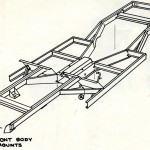
The Shorty Post Frame Offered by Glasspar from August 1952 Thru March 1953 Was a “Ladder” Style Frame – This Image is From One of Glasspar’s Early Brochures
During restoration, Tom kept the “Shorty Post” frame as original as possible. However, he added a stiffner across the top of the toe board – on top of the transmission. As Tom noted,
“There was frame flex side to side and I wanted to stiffen and strengthen the frame. I built an additional support member and bolted it in – so it could be removed to maintain originality if necessary. This also gave me another mounting point or flange to mount the firewall. The extra stiffener worked – it took the side-flex totally out.”
It’s interesting that Tom made this improvement – it’s just what Bill Tritt would have suggested. During my interviews with Tritt in 2007-2008, Bill shared that he moved away from Shorty Post frames in March 1953 and went with the Mameco built frames – to give more rigidity to a factory produced / sold car. The Shorty Post frames were excellent but they flexed too much – the Mameco X (cross) member frames gave the G2’s a much firmer ride.
Tom replaced the wooden floor and improved on the fit of the floor to the chassis too. He also moved the gas tank from sitting on the trunk floor to hanging from the frame members in the trunk area. This also increased the space available behind the front seats for storage.
Meeting Tom, Barb and Their Glasspar G2
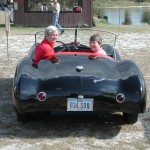
Be Sure to Say “Hi” to Tom and Barb – When You See Them and Their G2 at An Upcoming Concours d’Elegance
I first saw Tom and Barb’s G2 at the 2008 Barrington Concours d’Elegance near Chicago Illinois. Tom’s car was one of two 1950’s fiberglass sports cars that appeared at the Concours that day (the other being Guy Dirkin’s Byers SR100). Both of these cars graced the inner lawn of the Arlington Park Race Track with power and style. However, I didn’t have the pleasure of meeting Tom until nearly a year later.
In 2009, I met Tom, his lovely wife Barb, and their friend Denny at the 50th anniversary of the Glasspar G3 boats held in mid-state Florida. Tom was kind enough to participate in the Glasspar G3 celebration as the only G2 car represented. Most of the boat owners were completely surprised that Glasspar built a car too. Tom and Barb’s G2 was the hit – and the talk – of the weekend long show.
I thank Tom for his time in helping me put together the story of his car to share with you and appreciate his constant support – quite evidenced at the travel time it takes from Iowa to Chicago – and bringing his G2 sports car all the way down to Florida too! Tom’s quite a guy, and I think you’ll find both he and Barb are wonderful and interesting people to talk to – if you have the chance to meet them and see their G2 in the near future.
Thanks for a great story Tom – and a great friendship too!
Glass on….
Geoff
——————————————————————–
Click on the Images Below to View Larger Pictures
——————————————————————-
| Technical Specifications | |
| Other cars in collection: |
|
| Body |
|
| Designer |
|
| Body Work and Paint |
|
| Upholstery |
|
| Frame |
|
| Suspension |
|
| Engine (make/year) |
|
| Carburetion |
|
| Displacement |
|
| Horsepower (estimated) | |
| Transmission (type/year) |
|
| Rear Axle / driveshaft (open/closed driveshaft) |
|
| Dashboard / Gauges |
|
| Steering Wheel |
|
| Wheelbase |
|
| Track/Tread (front/rear) (distance between center line of tires) |
|
| Tire Size |
|
| Wheels / Rims |
|
| Curb Weight |
|
| Top Speed (0-60) |
|
| Special Features |
|
- Detailed Restoration on Chassis, Body, and Engine is Evident Everywhere You Look on Tom’s G2
- Tom and Barb Chandler’s Stunning 1952 Glasspar G2 – In the Family For Nearly 30 Years….
- Attractive Red/Black Color Combination and Exquisite Interior Make This One Impressive G2 – Short Post and Bill Tritt Would Be Proud…
- Be Sure to Say “Hi” to Tom and Barb – When You See Them and Their G2 at An Upcoming Concour
- The Short Post Frame Offered by Glasspar from August 1952 Thru March 1953 Was a “Ladder” Style Frame – This Image is From One of Glasspar’s Early Brochures
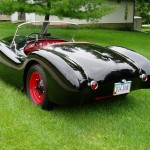
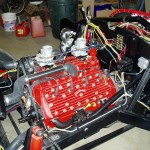

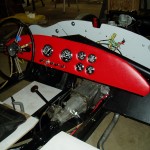
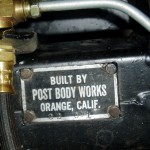
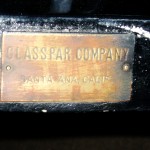
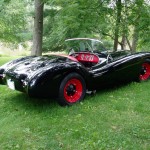
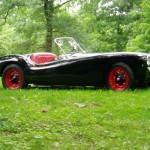
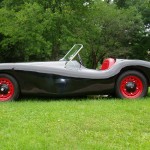
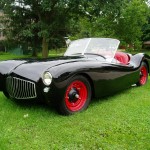
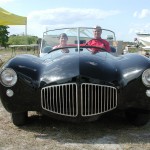
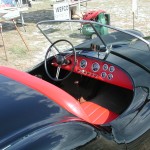
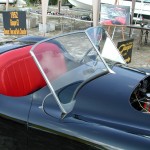
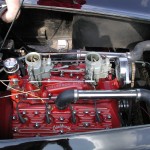
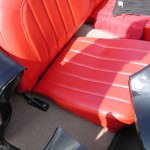
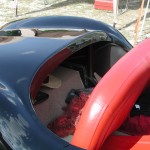
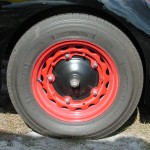
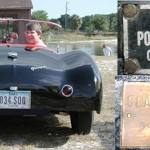
I used to have two Glasspar’s both found in California and both had hardtops that had no attachments. One had no doors and one had one door. Neither had drive trains and both were in primer when found in different locations. I remember that one car had a Shorty Post tag on the frame but I never noticed what the number was as neither cars had titles. There used to be a collector of Kaiser Darrins in Denver and he came by to look at my Darrin and I showed him the Glasspars and told him about how Bill Tritt was in on the building of the Darrins and he bought both of the Glasspars and the Darrin . That must have been about thirty years ago. I don’t remember his name but he must have been in his seventies then and probably had quite a collection. Maybe someone remembers who he was. It would be interesting to Find out more about Shorty Post and find his story and how it came about.
Need some information. This site is very informative.
I have a one door Glasspar g-2. It has never run in the years that I’ve had it but had previously been used for racing with a 1957 Cadillac Eldorado engine with 2 four barrel carbureators and automatic transmission. It has some fire damage on the right fender which the plan is to have a replacement using the left side fender. Does anyone know what gauges were installed in the dash? photographs are unclear. Thanks.